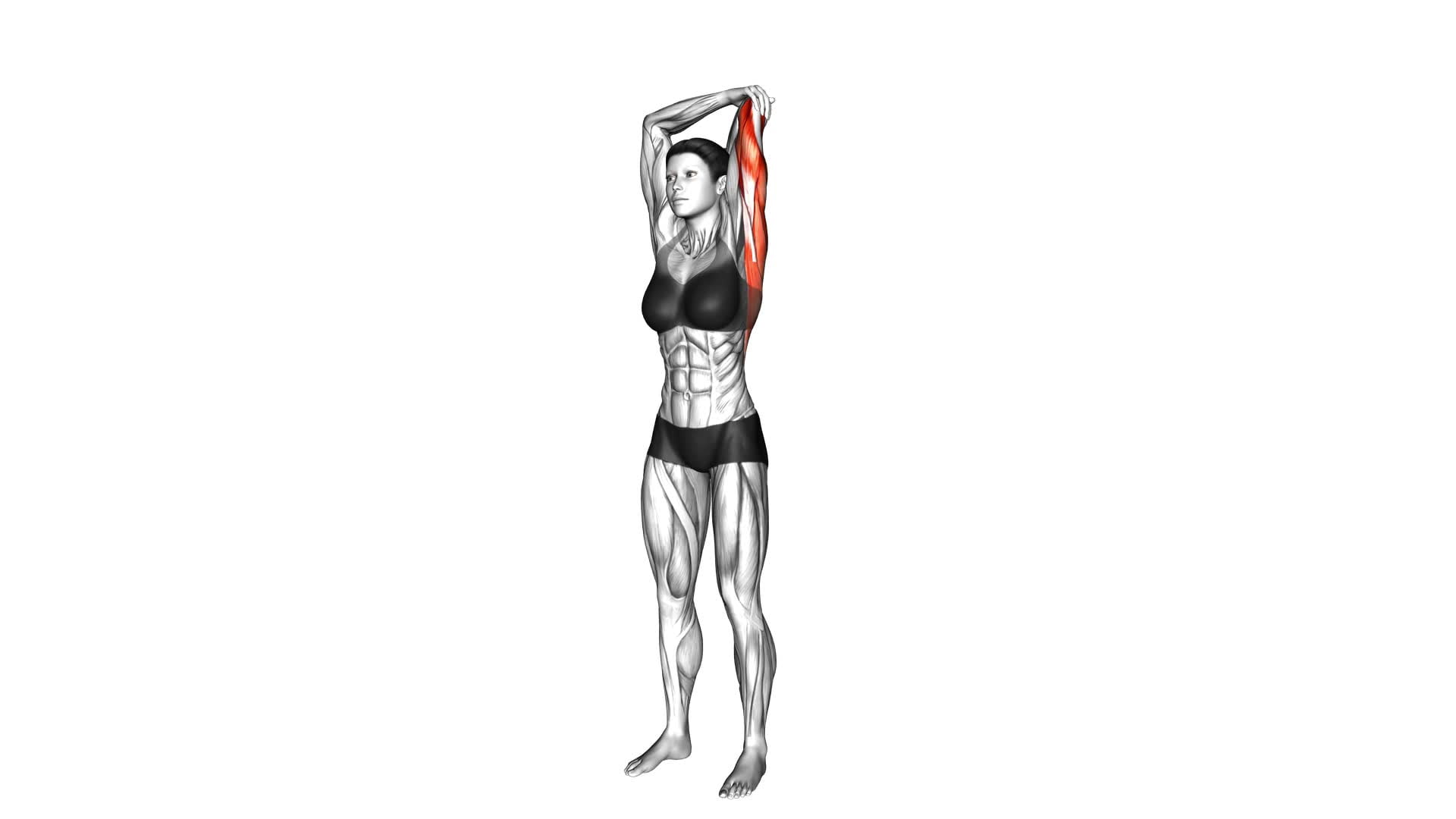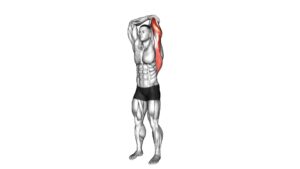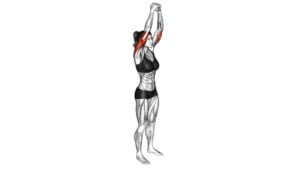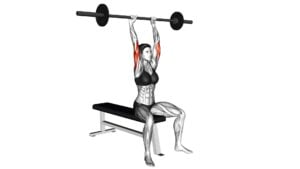Overhead Triceps Stretch (female) – Video Exercise Guide & Tips

Are you looking to improve your triceps flexibility and strength? In this video exercise guide, we'll show you how to perform the overhead triceps stretch, specifically for females.
Watch This Exercise Video
This simple yet effective stretch targets the triceps muscles, helping to increase range of motion and prevent injury. Grab a mat and get ready to feel the burn as we guide you through proper form and offer tips for a deeper stretch.
Let's get started!
Key Takeaways
- Increased flexibility in the triceps
- Potential for injury prevention
- Improved posture and alignment
- Customizable modifications for different fitness levels
Benefits of the Overhead Triceps Stretch
To maximize your results, incorporate the overhead triceps stretch into your routine to target and strengthen your triceps muscles. This stretch offers several benefits for your triceps and overall upper body strength.
One of the main benefits of the overhead triceps stretch is increased flexibility. By regularly performing this stretch, you can improve the range of motion in your triceps, allowing for better overall mobility in your arms.
Another benefit is the potential for injury prevention. Strengthening your triceps through this stretch can help stabilize the muscles and joints in your upper arm, reducing the risk of strains or tears during physical activities or sports.
Additionally, the overhead triceps stretch can also enhance your posture. As you stretch and strengthen your triceps, you'll naturally engage your core muscles, which can help improve your overall posture and alignment.
Finally, the overhead triceps stretch is easily modifiable to suit different fitness levels. Whether you're a beginner or an advanced athlete, you can adjust the intensity of this stretch by using different hand positions or incorporating resistance bands. This allows you to tailor the stretch to your specific needs and goals.
Incorporating the overhead triceps stretch into your routine can provide numerous benefits, including increased flexibility, injury prevention, improved posture, and customizable modifications.
Equipment Needed for the Exercise
To perform the Overhead Triceps Stretch, you'll need some essential equipment.
The primary equipment needed for this exercise is a resistance band or a towel. These items will help you effectively stretch and strengthen your triceps.
If you don't have access to these, you can also use a cable machine or a dumbbell as alternatives.
Essential Equipment for Exercise
You will frequently need specific equipment to perform the Overhead Triceps Stretch exercise. Having the right equipment is essential to ensure proper form and maximize the effectiveness of the exercise.
When it comes to equipment options for this exercise, you'll primarily need a sturdy, stable surface to lean against, such as a wall or a bench. This will provide the necessary support for your body as you stretch your triceps.
Additionally, using a resistance band or a towel can help intensify the stretch and provide added resistance. It's important to choose equipment that's suitable for your fitness level and allows you to perform the exercise safely and comfortably.
Alternatives for Equipment
For the Overhead Triceps Stretch exercise, consider using alternative equipment to achieve a similar effect and enhance the intensity of the stretch.
If you don't have access to equipment such as dumbbells or resistance bands, you can still effectively target your triceps using bodyweight exercises.
One option is to perform the exercise against a wall. Stand facing the wall with your feet shoulder-width apart. Place your hands on the wall at shoulder height and lean forward, keeping your elbows close to your ears.
Another option is to use a towel or a belt. Hold one end of the towel or belt with your right hand, and raise your right arm overhead. Reach behind your back with your left hand and hold onto the other end of the towel or belt. Gently pull the towel or belt with your left hand to deepen the stretch in your right tricep.
These alternatives can be done at home, making them perfect for a home workout.
Proper Form and Technique
Begin the overhead triceps stretch by standing with your feet shoulder-width apart. This exercise is great for improving flexibility and preventing injury in your triceps.
To properly perform the stretch, start by extending one arm overhead, bending at the elbow and reaching your hand towards the opposite shoulder blade. Use your other hand to gently push the elbow of the extended arm towards your head, feeling a stretch in the triceps muscle. Hold this position for 20-30 seconds, making sure to breathe deeply and relax into the stretch. Repeat on the other side.
It is important to maintain proper form during the overhead triceps stretch to maximize its benefits and avoid injury. Keep your spine straight and engage your core muscles to stabilize your body. Avoid arching your back or leaning to one side. Additionally, make sure to keep your shoulders relaxed and avoid shrugging them up towards your ears.
Remember, flexibility is key to preventing injury and improving overall performance. Incorporating the overhead triceps stretch into your routine can help you achieve better range of motion and reduce the risk of strain or tears in your triceps muscles.
Practice proper form and technique to get the most out of this exercise and enhance your flexibility.
Modifications for Beginners
If you're new to the overhead triceps stretch, there are some simple modifications you can make to make it easier.
For beginners, you can start by using a lighter weight or no weight at all.
You can also adapt the stretch by bending your elbows slightly or using a towel instead of a resistance band.
These modifications will help you ease into the stretch and gradually build flexibility and strength in your triceps.
Simple Beginner Modifications
You can easily modify the overhead triceps stretch to make it more suitable for beginners. If you're just starting out or have limited flexibility, these modifications will help you ease into the stretch and gradually increase your flexibility.
To begin, stand with your feet shoulder-width apart and extend one arm overhead. Instead of reaching behind your head with the opposite hand, simply place it on your lower back. This will provide support and stability as you stretch your triceps.
Hold the stretch for 15-30 seconds and then switch sides. Remember to breathe deeply and relax your shoulders.
As you become more comfortable, you can gradually increase the intensity of the stretch by reaching further behind your head.
Adapting for Less Flexibility
To adapt the overhead triceps stretch for less flexibility, start by placing your hand on your lower back instead of reaching behind your head with the opposite hand. This modification is particularly useful for individuals who've limited range of motion or are recovering from an injury.
By keeping the hand on the lower back, you can still stretch the triceps without straining or causing discomfort. As you become more comfortable and increase flexibility, you can gradually work towards reaching behind your head.
Remember to listen to your body and only push yourself as far as you can without causing any pain. With consistent practice, this modified version of the overhead triceps stretch can help you gradually improve your flexibility over time.
Easing Into the Stretch
As you begin to ease into the stretch, it's important to gradually increase the range of motion and intensity to avoid straining your muscles. To do this, start with some warm-up exercises to prepare your body for the stretch.
These can include light cardio, such as jogging in place or jumping jacks, to get your blood flowing and increase your body temperature. You can also perform dynamic stretches, such as arm circles or shoulder rolls, to loosen up your muscles.
Once you're warmed up, begin the overhead triceps stretch by extending one arm overhead and bending it at the elbow, reaching your hand towards the opposite shoulder blade. Remember to start with a comfortable range of motion and gradually increase it as you feel more comfortable.
Now, let's move on to some tips for a deeper stretch.
Tips for a Deeper Stretch
To achieve a deeper stretch during the overhead triceps stretch, focus on engaging your muscles and maintaining proper form. Here are some techniques and variations for advanced practitioners to help you achieve a deeper stretch:
- Increase the range of motion: Start with your arm extended overhead and slowly lower it behind your head. As you become more flexible, try reaching further down your back.
- Use a prop: Place your hand on a wall or use a towel or strap to assist in the stretch. By gently pulling on the towel or strap, you can increase the intensity of the stretch.
- Add resistance: Hold a dumbbell or resistance band in your hand while performing the stretch. This will provide additional resistance and help deepen the stretch.
- Try different angles: Experiment with different angles and positions of your arm to target different areas of your triceps. For example, you can try angling your arm slightly to the side or behind your head to focus on different muscle fibers.
By incorporating these deeper stretch techniques and variations, you can enhance the effectiveness of your overhead triceps stretch.
Now let's move on to the next section and discuss common mistakes to avoid.
Common Mistakes to Avoid
Avoid these common mistakes when performing the overhead triceps stretch. Proper form is essential to ensure that you're effectively targeting your triceps and avoiding potential injuries.
One common mistake is allowing your shoulders to hunch up towards your ears. To prevent this, keep your shoulders relaxed and down throughout the stretch.
Another mistake is arching your lower back. It's important to maintain a neutral spine by engaging your core muscles and avoiding any excessive curvature in your lower back.
Additionally, make sure to keep your elbows close to your head and pointing straight up towards the ceiling. Allowing your elbows to flare out to the sides can reduce the effectiveness of the stretch.
Lastly, avoid rushing through the stretch. Take your time and hold the stretch for at least 20-30 seconds on each side.
Frequently Asked Questions
How Many Times a Week Should I Perform the Overhead Triceps Stretch?
To reap the benefits of the overhead triceps stretch, it's recommended that you perform it a few times a week. This stretch targets the triceps muscles, helping to improve flexibility and range of motion in your arms.
If you're a beginner, you can modify the stretch by using a towel or resistance band to assist you. Remember to always listen to your body and start with a comfortable range of motion.
Can I Do the Overhead Triceps Stretch if I Have a Shoulder Injury?
If you have a shoulder injury, it's important to modify exercises to avoid further discomfort or damage.
The overhead triceps stretch may not be suitable for you in this case. However, there are alternative triceps stretches that can be done without putting strain on your injured shoulder.
It's always best to consult with a healthcare professional or a certified trainer who can guide you on the appropriate modifications and exercises for your specific situation.
Is It Better to Use a Resistance Band or Dumbbell for This Stretch?
When deciding between a resistance band or dumbbell for the overhead triceps stretch, consider the benefits of using a resistance band.
- It provides variable resistance, allowing you to adjust the intensity of the stretch.
- The band also helps improve muscle flexibility and joint stability.
On the other hand, a dumbbell can provide a more controlled and focused stretch.
Ultimately, choose the equipment that feels most comfortable and suits your specific needs and goals.
Can I Incorporate This Stretch Into My Regular Arm Workout Routine?
You can definitely incorporate this stretch into your regular arm workout routine. Incorporating stretches in your workout routine can provide several benefits.
Stretching helps improve flexibility, increases range of motion, and reduces the risk of injury. By adding the overhead triceps stretch, you can specifically target and stretch your triceps muscles, which can help improve your overall arm strength and mobility.
Remember to warm up before stretching and consult with a fitness professional if you have any concerns or specific goals.
How Long Should I Hold the Stretch for Maximum Effectiveness?
For maximum effectiveness, hold the stretch for at least 15 to 30 seconds. This will allow your triceps muscles to fully elongate and improve flexibility.
Beginners can modify the overhead triceps stretch by using a towel or resistance band to assist with the movement.
For advanced fitness levels, variations of the overhead triceps stretch can include using dumbbells or adding in a side bend to target different muscle groups.
Remember to always listen to your body and modify as needed.
Conclusion
In conclusion, the overhead triceps stretch is a beneficial exercise for stretching and strengthening the triceps muscles.
It requires minimal equipment and can be easily modified for beginners.
By maintaining proper form and technique, individuals can achieve a deeper stretch and avoid common mistakes.
Incorporating this exercise into your fitness routine can help improve flexibility and enhance overall arm strength.

Author
Years ago, the spark of my life’s passion ignited in my mind the moment I stepped into the local gym for the first time. The inaugural bead of perspiration, the initial endeavor, the very first surge of endorphins, and a sense of pride that washed over me post-workout marked the beginning of my deep-seated interest in strength sports, fitness, and sports nutrition. This very curiosity blossomed rapidly into a profound fascination, propelling me to earn a Master’s degree in Physical Education from the Academy of Physical Education in Krakow, followed by a Sports Manager diploma from the Jagiellonian University. My journey of growth led me to gain more specialized qualifications, such as being a certified personal trainer with a focus on sports dietetics, a lifeguard, and an instructor for wellness and corrective gymnastics. Theoretical knowledge paired seamlessly with practical experience, reinforcing my belief that the transformation of individuals under my guidance was also a reflection of my personal growth. This belief holds true even today. Each day, I strive to push the boundaries and explore new realms. These realms gently elevate me to greater heights. The unique combination of passion for my field and the continuous quest for growth fuels my drive to break new ground.







